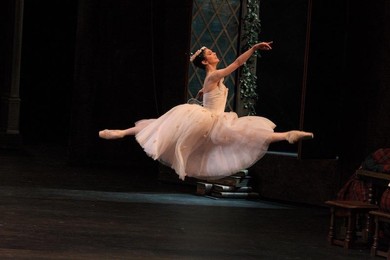New Stage
Premiere of this production: 20 Feb 2008 The performance has 1 intermission Running time: 1 hour 45 minutes The ballet, which has maintained the romantic dancing style for many years and became one of biggest theatrical legends of the 19th century. The illusiveness and unattainability of one’s dreams are revealed through the story of James, a young Scotsman. He has promised his heart to a girl from the local village but then comes across an enchanting spirit of the air, the sylph. Having forsaken everything on earth, the young man attempts to get close to this spectral beauty. La Sylphide is the pearl of the romantic repertoire. The Oleg Vinogradov production, for many years a staple of the Bolshoi Theatre repertoire, is in need of renovation. The new production injects this classical ballet with the joie de vivre and beauty which are the hallmarks of the Bournonville style. Johan Kobborg – one of the most distinguished dancers of his generation. On completing his studies at the Royal Danish Ballet School in 1991, he joined the Company. Having made his debut in La Sylphide, he was promoted to principal soloist. Since 1999, he has been principal dancer with London’s Royal Ballet. He has mounted several ballets by August Bournonville. La Sylphide, in his production, opened the 2005/06 season at Covent Garden. He has often danced in Bolshoi Theatre productions.
SynopsisAct I La Sylphide (The Sylph) is one of the world's oldest surviving romantic ballets. There were two versions of the ballet; the version choreographed by the Danish balletmaster August Bournonville (1805-1879) is the only version known to have survived.
On March 12, 1832, the first version of La Sylphide premiered at the Salle Le Peletier of the Paris Opera with choreography by Filippo Taglioni and music by Jean-Madeleine Schneitzhoeffer. Taglioni designed the work as a showcase for his daughter Marie. The ballet's libretto was written by tenor Adolphe Nourrit, the first Robert in Meyerbeer's Robert Le Diable, an opera which introduced the dancer Marie Taglioni in its dances section The ballet of nuns. Nourrit's scenario was loosely based on a story by Charles Nodier, Trilby, ou Le lutin d'Argail, but swapped the genders of the protagonists — a goblin and a fisherman's wife in Nodier; a sprite and a farmer in the ballet. In 1836, La Sylphide was choreographed anew by the Danish balletmaster August Bournonville with music by Herman Severin Løvenskiold. Bournonville had intended to present a revival of Taglioni's original version in Copenhagen with the Royal Danish Ballet, but the Paris Opera demanded too high a price for Schneitzhoeffer's score. In the end, Bournonville mounted his own production based on the original libretto. The premiere took place on November 28, 1836. The Bournonville version has been danced in its original form by the Royal Danish Ballet ever since its creation and remains one of Bournonville's most celebrated works. Modern interpreters of Bournonville's version include Eva Evdokimova and Lis Jeppesen, whose performance is recorded on DVD. In 1892, Marius Petipa mounted a revival of Taglioni's original La Sylphide for the Imperial Ballet, with additional music by Riccardo Drigo. A variation Drigo composed for the ballerina Varvara Nikitina in Petipa's version is today the traditional solo danced by the lead ballerina of the famous Paquita Grand Pas Classique, interpolated by Anna Pavlova in 1904. In 1972, a revival of the Taglioni version was staged by Pierre Lacotte for the Paris Opera Ballet. Since Taglioni's choreography has been irretrievably lost, Lacotte's choreography is based on prints, notes, drawings, and archival materials from the era of the ballet's premiere. Lacotte's choreography is in the style of the period but entirely new and has been criticised by some as inauthentic. Interpreters of the role of Lacotte's version at the Opera National de Paris include Ghislaine Thesmar (Lacotte's wife) and Aurelie Dupont. Both artists have recorded their work on DVD and video. La Sylphide is often confused with Les Sylphides, another ballet involving the mythical sylph, or forest sprite. The latter was choreographed by Michel Fokine for the Ballets Russes as a short performance. Though inspired by La Sylphide, it was meant to be performed as an independent ballet with its own merits. John Barnett's 1834 opera The Mountain Sylph is based on the storyline of La Sylphide; this opera's plot was in turn satirized by W. S. Gilbert in the 1882 Savoy Opera, Iolanthe. © Photo by Yelena Fetisova © wikipedia | ||||||||||


